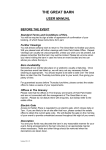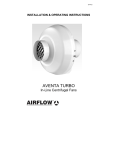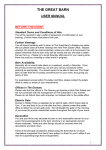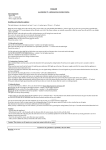Transcript
ENGLISH WATERDETECT® - OPERATING INSTRUCTIONS Where to use Place the unit near to the water heater, dishwasher, washing machine, sinks, lavatories, refrigerator, water filtration systems, toilets, water softener, fish tank, house plants, basement, garage, sump pump or anywhere hoses or pipes are under pressure, or might freeze or break. For maximum protection, it is recommended that you place the unit under, or near, each such appliance or potential area or leaks. Product Features - Sounding a loud alarm signal of exceeding 85 dB. - Using advanced electronic design to accurately detect the water leakage. - Easy installation and maintenance. - Fully automatic operation. - Ergonomic design. Instructions Some promotional units come with a 9-V battery included, but not connected. The battery will chirp to warn when the battery is low, by sounding a single beep every minute. (check your unit/battery every year). The unit does not have an on/off switch. With a live battery installed, it is armed and operating. The unit will begin signalling as soon as water contacts its 3 sensors. The alarm signal is a quick buzzer. In the event that no one is present to respond, the alarm will go of continuously. The overall duration of the battery will depend on the strength of the battery to begin with. If the unit sounds and water is present, turn off the local water valve (if available) or turn off the water to the whole house as quickly as possible. The unit can be made to stop by simply removing it from the water, or removing the battery. After detection of water, remove the battery and wipe the unit dry, and then set it in a dry place with good ventilation to insure internal components are dry before replacing the battery. If the unit is sounding and there is no apparent water present, check carefully for small leaks in the area first, wipe the sensors dry and follow the instructions above. If the alarm still sounds when placed into position and there is no moisture present, it is possible that the floor is electrically conductive. In this case, try placing the unit on a small section of paper towel. If the alarm still sounds, the unit may be malfunctioning. Place the unit at the lowest point of flooring underneath or beside the areas of potential leaks. The lowest point can be found by placing a marble or round object on the floor to see which way it rolls. An alternative is to use a level. In areas where the floor is not sloped enough to detect, place the unit where water is most likely to be sourced from: such as underneath valves, fittings, or the lowest point of tubing. Whenever possible, face the alarm speaker outwards towards a open space. Caution! - The metal leads on the back or on the bottom of the unit must be facing downwards for the alarm to work. - Prolonged exposure to loud sounds may damage hearing. - Do not place the unit in water or wipe with a wet sponge or towel to clean. Clean the unit only with a dry cloth. - Any tampering with or repairing the unit voids the warranty. - Alarms are not foolproof. Like any other electronic device, they are made of components that can wear or fail at any time. Their performance is especially subject to impact, dust, flooding and lack of proper maintenance. They cannot work without power. If the battery is not correctly installed, is missing, or depleted, the alarm will be inoperative. - The unit will not work without a battery installed. The battery must be installed immediately, or the unit will fail. Read and follow instructions or unit will not operate properly. - Although the unit is designed to be loud enough to be heard in nearby rooms, it may not be heard. - The unit will not sound if the water leak does not reach the unit. Leaks that occur in adjacent or nearby areas where water does not travel in the path of the sensors will not trigger the alarm. -Although the unit is water resistant, it is not waterproof and flooding can damage the electronics and inhibit the function of the unit. - The unit has a limited life. The unit should be replaced immediately if it is not operating properly. It is recommended that each unit be replaced every five years in normal operating conditions. - Never drop the unit. - Although the unit is made to detect water leakage, it is an electronic device susceptible to damage and malfunction. - The unit is solely meant to be a helpful device with no guarantees expressed or implied. - Check with your insurance company for possible premium discounts when using this system. If you have any questions or problems, call your fitter.








